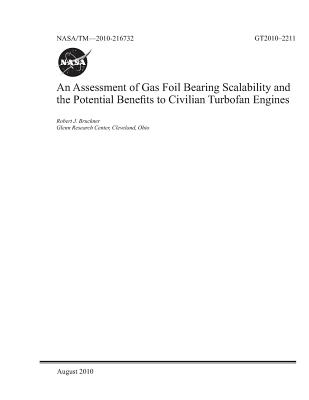
An Assessment of Gas Foil Bearing Scalability and the Potential Benefits to Civilian Turbofan Engines
Paperback
Currently unavailable to order
Please enter your email and a message will be sent to you when this product becomes available on our website.
ISBN13: 9781794322967
Publisher: Independently Published
Published: Jan 19 2019
Pages: 30
Weight: 0.21
Height: 0.06 Width: 8.50 Depth: 11.00
Language: English
Also in
Astronomy & Space
Pillars of Creation: How the James Webb Telescope Unlocked the Secrets of the Cosmos
Panek, Richard
Hardcover
Reentry: Spacex, Elon Musk, and the Reusable Rockets That Launched a Second Space Age
Berger, Eric
Hardcover
Ancient Astrology in Theory and Practice: A Manual of Traditional Techniques, Volume I: Assessing Planetary Condition
George, Demetra
Paperback
A City on Mars: Can We Settle Space, Should We Settle Space, and Have We Really Thought This Through?
Weinersmith, Zach
Weinersmith, Kelly
Hardcover
Our Moon: How Earth's Celestial Companion Transformed the Planet, Guided Evolution, and Made Us Who We Are
Boyle, Rebecca
Hardcover
The Secret Life of the Universe: An Astrobiologist's Search for the Origins and Frontiers of Life
Cabrol, Nathalie A.
Hardcover
Smithsonian Atlas of Space: A Map to the Universe from the Big Bang to the Future
Launius, Roger D.
Hardcover
A Crack in Everything: How Black Holes Came in from the Cold and Took Cosmic Centre Stage
Chown, Marcus
Hardcover
The Six: The Extraordinary Story of the Grit and Daring of America's First Women Astronauts
Grush, Loren
Paperback
Ojibwe Sky Star Map - Constellation Guidebook: An Introduction to Ojibwe Star Knowledge
Gawboy, Carl
Lee, Annette Sharon
Wilson, William Peter
Paperback
2025 Night Sky Almanac: A Month-By-Month Guide to North America's Skies from the Royal Astronomical Society of Canada
Mortillaro, Nicole
Paperback
Dakota/Lakota Star Map Constellation Guidebook: An Introduction to D(L)akota Star Knowledge
Rock, Jim
O'Rourke, Charlene
Lee, Annette Sharon
Paperback
Star Bound: A Beginner's Guide to the American Space Program, from Goddard's Rockets to Goldilocks Planets and Everything in Between
McCandless, Bruce
Carney, Emily
Hardcover
To Infinity and Beyond: A Journey of Cosmic Discovery
Tyson, Neil Degrasse
Walker, Lindsey Nyx
Hardcover
Photographic Atlas of the Moon: A Comprehensive Guide for the Amateur Astronomer
Reeves, Robert
Hardcover
Spirits Dancing: The Night Sky, Indigenous Knowledge, and Living Connections to the Cosmos
Lee, Annette S.
Novitsky, Travis
Paperback
Bringing Columbia Home: The Untold Story of a Lost Space Shuttle and Her Crew
Leinbach, Michael D.
Ward, Jonathan H.
Paperback
Biocentrism: How Life and Consciousness Are the Keys to Understanding the True Nature of the Universe
Lanza, Robert
Berman, Bob
Paperback
Webb's Universe: The Space Telescope Images That Reveal Our Cosmic History
Aderin-Pocock, Maggie
Hardcover
Constellation Finder: A Guide to Patterns in the Night Sky with Star Stories from Around the World
Miller, Dorcas S.
Paperback
The Astronomy Handbook: The Ultimate Guide to Observing and Understanding Stars, Planets, Galaxies, and the Universe
Schilling, Govert
Hardcover
The Elegant Universe: Superstrings, Hidden Dimensions, and the Quest for the Ultimate Theory
Greene, Brian
Paperback
The Backyard Stargazer's Bible: Discover Constellations, Galaxies, Nebulae, Meteorites, and More
Federman, Rachel
Ridpath, Ian
McIntyre, Mary
Hardcover
Unseen Universe: Space as You've Never Seen It Before from the James Webb Space Telescope
Harper, Caroline
Hardcover
Life After Life: The Bestselling Original Investigation That Revealed Near-Death Experiences
Moody, Raymond
Paperback
Deep Space: Beyond the Solar System to the Edge of the Universe and the Beginning of Time
Schilling, Govert
Paperback
The Stage of Time: Secrets of the Past, The Nature of Reality, and the Ancient Gods of History
LaCroix, Matthew R.
Paperback
Painting the Cosmos: How Art and Science Intersect to Reveal the Secrets of the Universe
Imara, Nia
Paperback
Hidden in the Heavens: How the Kepler Mission's Quest for New Planets Changed How We View Our Own
Steffen, Jason
Hardcover
Space Oddities: The Mysterious Anomalies Challenging Our Understanding of the Universe
Cliff, Harry
Hardcover
Hamlet's Mill: An Essay Investigating the Origins of Human Knowledge and Its Transmissions Through Myth
de Santillana, Giorgio
Von Dechend, Hertha
Paperback
Through the Glass Ceiling to the Stars: The Story of the First American Woman to Command a Space Mission
Collins, Eileen M.
Ward, Jonathan H.
Hardcover
A Brief Tour of Higher Consciousness: A Cosmic Book on the Mechanics of Creation
Bentov, Itzhak
Paperback
National Geographic Stargazer's Atlas: The Ultimate Guide to the Night Sky
National Geographic
Trefil, James
Wei-Haas, Maya
Hardcover
The Science of Why We Exist: A History of the Universe from the Big Bang to Consciousness
Coulson, Tim
Hardcover
How to Read Nature: Awaken Your Senses to the Outdoors You've Never Noticed
Gooley, Tristan
Hardcover
The Shortest History of Our Universe: The Unlikely Journey from the Big Bang to Us
Baker, David
Paperback
The Allure of the Multiverse: Extra Dimensions, Other Worlds, and Parallel Universes
Halpern, Paul
Hardcover
Welcome to the Universe: An Astrophysical Tour
Tyson, Neil Degrasse
Strauss, Michael A.
Gott, J. Richard
Hardcover
Observer's Sky Atlas: The 500 Best Deep-Sky Objects with Charts and Images
Karkoschka, Erich
Hardcover
Cosmic Queries: Startalk's Guide to Who We Are, How We Got Here, and Where We're Going
Trefil, James
Tyson, Neil DeGrasse
Hardcover
The Natural Navigator, Tenth Anniversary Edition: The Rediscovered Art of Letting Nature Be Your Guide
Gooley, Tristan
Paperback
The Extraterrestrial Species Almanac: The Ultimate Guide to Greys, Reptilians, Hybrids, and Nordics
Campobasso, Craig
Paperback
Attention Is Discovery: The Life and Legacy of Astronomer Henrietta Leavitt
Von Mertens, Anna
Hardcover
Pocket Nature Series: Cloud Spotting: Observe the Clouds to Quiet Your Mind
Schreiner, Casey
Hardcover
Back to Earth: What Life in Space Taught Me about Our Home Planet--And Our Mission to Protect It
Stott, Nicole
Hardcover
You Are the Universe: Discovering Your Cosmic Self and Why It Matters
Chopra, Deepak
Kafatos, Menas C.
Paperback
Supermassive: Black Holes at the Beginning and End of the Universe
Trefil, James
Satyapal, Shobita
Hardcover
Until the End of Time: Mind, Matter, and Our Search for Meaning in an Evolving Universe
Greene, Brian
Paperback
Starlore of the Constellations: The Astronomy, Myth and Symbolism of the Night Sky
Cornelius, Geoffrey
Paperback
Do Your Ears Pop in Space? and 500 Other Surprising Questions about Space Travel
Mullane, R. Mike
Paperback
The Beginner's Guide to Constructing the Universe: The Mathematical Archetypes of Nature, Art, and Science
Schneider, Michael S.
Paperback
The End of Night: Searching for Natural Darkness in an Age of Artificial Light
Bogard, Paul
Paperback
Apollo 11: A Complete Guide to the Historic Moon Landing (The History of Nasa's Two Most Notorious Disasters)
Peters, Vivian
Paperback
A Cloud a Day: (Cloud Appreciation Society Book, Uplifting Positive Gift, Cloud Art Book, Daydreamers Book)
Pretor-Pinney, Gavin
Hardcover
A Brief Welcome to the Universe: A Pocket-Sized Tour
Gott, J. Richard
Strauss, Michael A.
Tyson, Neil Degrasse
Paperback
The Elegant Universe: Superstrings, Hidden Dimensions, and the Quest for the Ultimate Theory
Greene, Brian
Hardcover
The Glass Universe: How the Ladies of the Harvard Observatory Took the Measure of the Stars
Sobel, Dava
Paperback
The Universe Story: From the Primordial Flaring Forth to the Ecozoic Era--A Celebration of the Unfol
Swimme, Brian
Paperback
Can't Get Enough Space Stuff: Fun Facts, Awesome Info, Cool Games, Silly Jokes, and More!
Drimmer, Stephanie Warren
Paperback
Aliens Like Us?: An Anthropologist's Field Guide to Intelligent Extraterrestrial Life
Aveni, Anthony
Hardcover
Constellations: The Story of Space Told Through the 88 Known Star Patterns in the Night Sky
Schilling, Govert
Hardcover
The Sky Atlas: The Greatest Maps, Myths, and Discoveries of the Universe
Brooke-Hitching, Edward
Hardcover
Welcome to the Universe in 3D: A Visual Tour
Strauss, Michael A.
Gott, J. Richard
Tyson, Neil Degrasse
Hardcover
Off-Grid Solar Power Made Easy: Design and Installation of Photovoltaic system For Rvs, Vans, Cabins, Boats and Tiny Homes
Jordan, William
Hardcover
The Zoologist's Guide to the Galaxy: What Animals on Earth Reveal about Aliens--And Ourselves
Kershenbaum, Arik
Hardcover
Still as Bright: An Illuminating History of the Moon, from Antiquity to Tomorrow
Cokinos, Christopher
Hardcover
Stars and Planets: The Most Complete Guide to the Stars, Planets, Galaxies, and Solar System - Updated and Expanded Edition
Ridpath, Ian
Tirion, Wil
Paperback
A Brief History of Black Holes: And Why Nearly Everything You Know about Them Is Wrong
Smethurst, Becky
Paperback


 Sign-In
Sign-In Cart
Cart